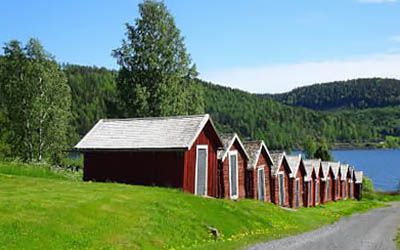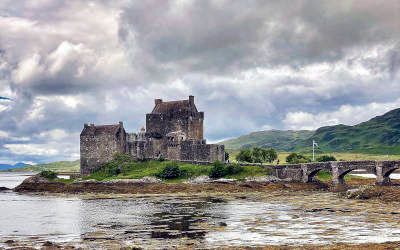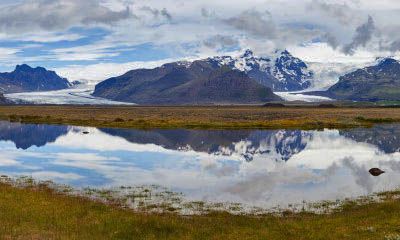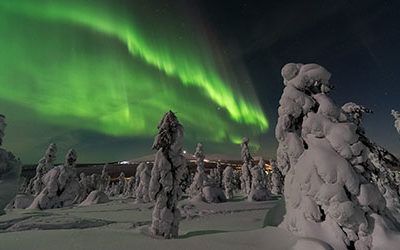Northern Europe
When you mention Northern Europe, most people immediately think of the Vikings and the deep fjords and steep mountains of Norway. But also, the Northern Lights, dog sleds in Lapland and the many glaciers and geysers in Iceland. And then of beautiful, wooden houses in cosy villages and towns. According to the United Nations classification, the United Kingdom, Ireland, the Channel Islands and the Baltic States also fall under Northern Europe. We present the many countries of this European region in alphabetical order.
Denmark
This small, coastal country has a unique past of the once so-powerful realm of the Vikings. The gently sloping landscape, full of castles and beautiful country houses, is perfect for wonderful cycling and walking tours.
Estonia
Most tourists go to Estonia because of Tallinn, the best-preserved medieval city in Europe. But this Baltic state, which has more than 1500 islands, also has a beautiful, unspoilt nature to offer travellers.
Finland
Finland is a particularly large country with small towns and very extensive nature reserves. You will find about 188,000 lakes and almost as many islands. In Lapland in the north, where Santa Claus also lives, you can see the northern lights in winter.
Iceland
This rugged island enjoys a spectacular landscape of volcanoes, glaciers, geysers and waterfalls. Iceland is also the country of the lovely warm Blue Lagoon. For the northern lights, you should go there in the months of September or October.
Ireland
This green island with a very friendly, musical population, has wild, rugged landscapes. Ireland also has a particularly rich history and culture. We find the country a wonderful destination for weekend trips to cities like Dublin or Cork too.
Latvia
The capital of Latvia, Riga, is rightly listed as a World Heritage Site. But also, the enormous waterfall at Kuldiga and the medieval castle ruins of Cesis are tourist attractions. Half of the country is nature so you can go on amazing hikes.
Lithuania
Lithuania’s historical heritage distinguishes it from the other two Baltic states. Lithuania, once the largest country in Europe, has a rich history and especially nature lovers much to offer. Think of vast forests and many blue lakes.
Norway
This particularly large country is famous for its deep fjords, steep mountains and wooden churches. Norway has a rich and interesting culture with roots in agriculture and fishing. The country offers endless opportunities for fantastic hiking.
Sweden
Although there are some interesting cities and historical attractions, it is nature that attracts the most tourists. This largest country in Scandinavia offers a lot of beautiful and neatly marked hiking trails. In addition, it is great for kayaking.
United Kingdom
The United Kingdom consists of Great Britain (England, Scotland and Wales) and Northern Ireland. The country has a lot to offer both the British themselves and foreign tourists. Besides a rich history and culture, picturesque villages and beautiful landscape attract many visitors.
Sweden
Sweden is not just the land of ABBA, IKEA and Pippi Longstocking. For peace and nature seekers, the country is best known for its pristine nature. Sweden has countless vast forests, thousands of lakes, and many national parks and nature reserves. The beautiful nature...
Bonnie Scotland
Finland is a particularly large country with small towns and very extensive nature reserves. You will find about 188,000 lakes and almost as many islands. In Lapland in the north, where Santa Claus is said to live, you can see the northern lights in winter. ...
Iceland, land of geysers, glaciers, sagas and trolls
Australia is known to many for its kangaroos and koalas, Ayers Rock (Uluru), its beaches, deserts, the 'bush', the 'Outback', the first Grand Slam tennis tournament and the first Grand Prix of the New Year, and the major cities like Sydney, Melbourne and Brisbane......
Finland
Finland is a particularly large country with small towns and very extensive nature reserves. You will find about 188,000 lakes and almost as many islands. In Lapland in the north, where Santa Claus is said to live, you can see the northern lights in winter. ...
Climate
Despite the northern location of Scandinavia and Iceland, these countries have a relatively mild climate. Although the north has a subarctic climate, the south has a temperate climate. The summers are pleasantly warm. Deeper inland it can get very cold in the winter. Under the influence of the Atlantic Ocean, the climate on the (south) west coast of Norway is less stable than in the neighbouring countries.
The Baltic states have a more temperate maritime climate with winters that are not too cold and fairly cool summers. Spring is the driest, autumn the wettest.
Tourists usually do not go to Ireland and the United Kingdom because of the weather in particular. But due to the influence of the Atlantic Ocean there is a mild, humid climate with excellent temperatures. Except perhaps for the highlands in Scotland, you can do outdoor activities all year round. Ireland and the west of the UK have more rainfall than the eastern areas. Ireland also gets a lot of wind.
Travelling within Northern Europe
A comfortable way to travel between the big cities on the Baltic Sea is by ferry. These ships are often large and luxurious and also call at the more distant places on the Norwegian west coast. The train is another option for the south of the Scandinavian countries of Norway, Sweden and Finland. The train connection between Bergen and Oslo is spectacular in fact.
The further north you go, the fewer train and bus connections there are. You’re better off by plane or car. Keep in mind that fuel and car rental in these Scandinavian countries is expensive. If you visit the Baltic States, then you should definitely consider the bicycle as a means of transport. The three states offer many, fantastic cycling routes!
In Ireland, it’s best to travel by car or bus. The road network has improved so much in recent decades that flying is hardly worth it. The country also offers beautiful landscapes for cycling. However, road and weather conditions vary widely, so make sure you have a good touring bike with solid tyres. Along the many cycle routes there are numerous campsites for long-distance cyclists.
Travelling by train is popular in both Great Britain and Northern Ireland. The island has one of the safest and most extensive railways in the world. For example, the National Rail network covers approximately 34,000 km in most of England, Scotland and Wales. There are more than 2,600 train stations. Another option is a (rental) car. Many tourists also use campervans. And just like in Ireland, you also have many cycling routes in Great Britain.
Healthcare
In general, healthcare in the Baltic States is well developed. Pharmacies are usually open between 10:00 am and 7:00 pm, some also at night and weekends. Please note that you must pay in cash for medical care. In that case, inform your insurance company immediately. It is best to drink drinking water from bottles. In the Baltic states, there are cases of tick encephalitis.
Healthcare in the Scandinavian countries and Iceland is of a high standard. In some areas, except Iceland, tick encephalitis occurs. For this reason, avoid products that contain raw milk, such as some cheeses. Tap water in these countries is generally good to drink. In these countries, especially in the summer month of July, protect yourself well from mosquito bites. Just like in the Baltic states, in some cases you have to pay for medical care in cash. Make sure you have good travel insurance that covers such costs. For Iceland, your insurance also has to cover the possible costs of a rescue helicopter. Because of the limited number of easily accessible roads on the island, helicopters are often used.
Health care in the United Kingdom and Ireland is of good quality. Pharmacies are open every day of the week, except Sundays, during the day. Please note that prescription drugs are often very expensive in the UK and therefore special drugs should be carried in sufficient quantities.
Personal travel advice
Northern Europe is too large and diverse to provide general travel advice. Do you like city trips? Or more long cycling or walking tours? We will be happy to give personal travel advice, considering your own wishes. See the dedicated page where you can request personal travel advice.




